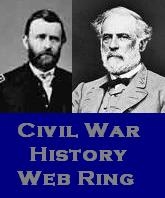A lot of great Civil War book lists are appearing here in the blogosphere at this time of year. Eric Wittenberg and Glenn LaFantasie have their Top 12, and John Hoptak is previewing new books coming out in 2011. As I approach the second anniversary of this blog, I recently added the 2,500th quote to my database. I thought it might be interesting to display a list of the 34 books that I read over the past two years from where I took many of my quotes.
Combined Operations in the Civil War
By Rowena Reed. 1 quote
Shanks The Life and Wars of General Nathan G. Evans, CSA
By Jason H. Silverman; Samuel N. Thomas; Beverly D. Evans.. 4 quotes
A Matter of Hours - Treason at Harper's Ferry
By Paul R. Teetor. 5 quotes
By Howard Jones. 6 quotes
West Pointers in the Civil War
By Wayne Wei-siang Hsieh. 6 quotes
By Timothy Johnson. 7 quotes
No Disgrace to My Country: The Life of John C. Tidball
By Eugene Tidball. 9 quotes
On Hallowed Ground: The Story of Arlington Cemetery
By Robert M. Poole. 14 quotes
A Guide to the Antietam Farmsteads
By Kevin Walker. 20 quotes
Sealed with Their Lives The Battle of Crampton's Gap
By Timothy J. Reese. 20 quotes
By Walter Hebert. 22 quotes
George Gordon Meade and the War in the East
By Ethan S. Rafuse. 26 quotes
By John Hoptak. 38 quotes
The Mexican War Diary and Correspondence of George B. McClellan by George B. McClellan. Thomas W. Cutrer editor. 39 quotes
Antietam: Essays on the 1862 Maryland Campaign
Edited By Gary Gallagher. 42 quotes
George B McClellan: the Young Napoleon
By Stephen W. Sears. 46 quotes
Mark A. Snell editor 48 quotes
Maryland Campaign of 1862 Volume 1
Thomas Clemens editor. 50 quotes
By Bruce Catton. 50 quotes
Recollections of a Confederate Staff Officer
By Moxley Sorrel. 58 quotes
General A.P. Hill The Story of a Confederate Warrior
By James I. Robertson. 62 quotes
Snell, Mark A editor. 64 quotes
By Herman Hattaway, and Archer Jones. 70 quotes
Counter Thrust: From the Peninsula to the Antietam
By Benjamin Franklin Cooling. 71 quotes
General John Pope A Life for the Nation
By Peter Cozzens. 73 quotes
By Joseph Harsh. 83 quotes
Lee's Maverick General: Daniel Harvey Hill
By Hal Bridges. 95 quotes
Reading the Man - A Portrait of Robert E. Lee Through His Private Letters
By Elizabeth Brown-Pryor Elizabeth. 97 quotes
Commander of all Lincolns Armies A Life of Henry Halleck
By John Marszalek. 99 quotes
Until Antietam The Life and Letters of Major General Israel B. Richardson
Jack C. Mason. 99 quotes
A Diary of Battle: The Personal Journals of Colonel Charles S. Wainwright 1861-1865
By Allen Nevinst. 135 quotes
Stonewall Jackson - The Man The Soldier The Legend
By James I. Robertson. 170 quotes
Cavalryman of the Lost Cause Jeb Stuart
By Jeffry Wert. 246 quotes
The Antietam Campaign (Military Campaigns of the Civil War
Gary Gallagher, editor. 325 quotes



























